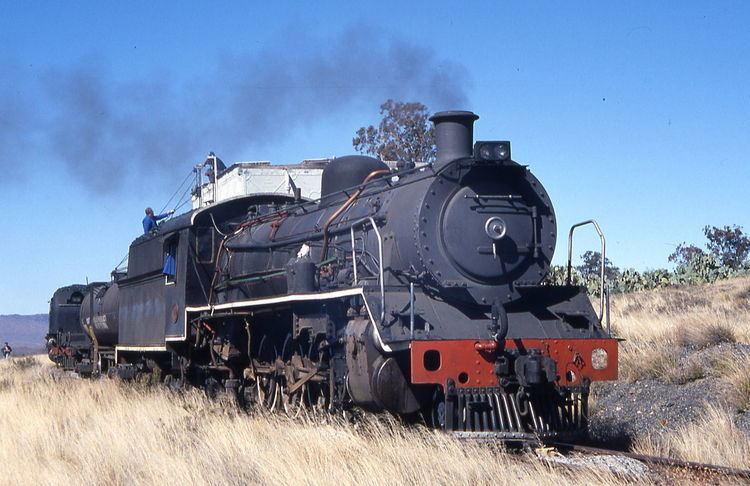Power type Steam Serial number 9827-9840 Build date 1930 | ||
 | ||
Designer South African Railways(Col F.R. Collins DSO) | ||
The South African Railways Class 19B 4-8-2 of 1930 is a steam locomotive.
Contents
- Manufacturer
- Characteristics
- Watson Standard boilers
- South African Railways
- Industrial
- Illustration
- References
In 1930, the South African Railways placed fourteen Class 19B steam locomotives with a 4-8-2 Mountain type wheel arrangement in service. One of them was later reboilered and reclassified to Class 19BR.
Manufacturer
Fourteen Class 19B 4-8-2 Mountain type steam locomotives were built in Germany by Berliner Maschinenbau AG (BMAG), the former L. Schwartzkopff, and were delivered in 1930. All but one were built with Walschaerts valve gear.
Characteristics
The South African Class 19B locomotive, numbered in the range from 1401 to 1414, was a later model of the original Class 19, which had been designed in 1928 under the supervision of Colonel F.R. Collins DSO, Chief Mechanical Engineer (CME) of the SAR from 1922 to 1929. It was virtually identical to the Class 19, apart from the wheelbase of the front bogie, which had been increased from 6 feet 2 inches (1,880 millimetres) to 6 feet 4 inches (1,930 millimetres) to improve the clearance between the cylinders and the bogie wheels, since the bogie wheels of predecessors Classes 19 and 19A fouled the cylinder covers on sharp curves. The longer wheelbase bogie also facilitated the removal of cylinder covers at running sheds. Because of this difference, the new engines were designated Class 19B.
The first thirteen Class 19B locomotives were delivered with Walschaerts valve gear, but no. 1414 was equipped with Caprotti valve gear as an experiment. After thirteen years, however, the Caprotti valve gear was removed at the Uitenhage workshops and replaced with Walschaerts valve gear in January 1943. The experiment did result in the successor Class 19C being built with Rotary Cam Poppet valve gear.
The trailing bissel truck was constructed with three holes to enable the compensating beam to be fitted at three locations, which enabled it to be used to redistribute the engine's weight on the trailing axle. The axle load weights as shown for the Class 19B are with the trailing truck compensating beam pin in the rearmost of the three holes. The axle load weights as shown for the Class 19BR are also with the trailing truck compensating beam pin in the rearmost of the three holes.
As built, the Class 19B was delivered with Type MT tenders with a 12 long tons (12.2 tonnes) coal and a 6,000 imperial gallons (27,300 litres) water capacity, even though the axle load of 16 long tons 11 hundredweight (16,820 kilograms) of these tenders exceeded the permissible limits on the branchlines for which the Class 19B was intended. Upon delivery, their new Type MT tenders were exchanged for the smaller modified Type MP1 tenders from some of the reboilered mainline locomotives. The Type MP1 had a lighter axle load of 13 long tons 15 hundredweight (13,970 kilograms) and was therefore more suitable for branchline work. This policy was followed with all the Classes 19B, 19C and 19D, except the last batch of Class 19D which was delivered with Type MX torpedo tenders.
Watson Standard boilers
From the 1930s, many serving locomotives were reboilered with a standard boiler type, designed by then CME A.G. Watson as part of his standardisation policy. Such Watson Standard reboilered locomotives were reclassified by adding an "R" suffix to their classification.
When Class 19B no. 1410 was reboilered with a Watson Standard no. 1A boiler, it therefore became the sole member of Class 19BR. It was not equipped with a Watson cab with its distinctive inclined front in the process, but retained its original vertical fronted cab. It did, however, have the tell-tale rectangular regulator cover, just to the rear of the chimney, which identified it as a Watson Standard reboilered locomotive.
South African Railways
Some Class 19B locomotives served around Cape Town and between Kimberley and Vryburg, but most of them spent their working lives on the line between Graaff Reinet and Rosmead across the Lootsberg Pass, until they were eventually replaced by Class 19D locomotives. A couple were also allocated to Sydenham in Port Elizabeth and occasionally worked on the Grahamstown branch. By 1977, they were all withdrawn from service.
Industrial
After being retired from SAR service, several were sold into a second career in industrial service.
Illustration
The main picture shows the Transnet National Collection's preserved Class 19B no. 1412 taking water at Blouwater before piloting a Class GMAM Garratt and the Union Express across the Lootsberg Pass, c. 2001. When retired, no. 1412 was initially plinthed at Middelburg in the Cape Province and later restored. During 2016, she re-entered service as Bailey, restored at Voorbaai for the Ceres Rail Company.
